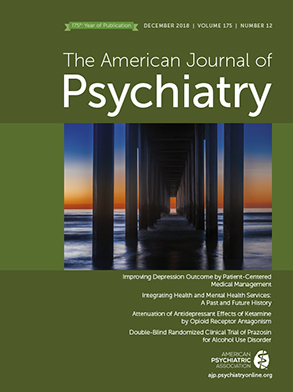2018 in Review
Returning to the Doctor-Patient Alliance
In Pursuit of a Mechanistic Understanding of the Neurobiology of Suicide
Journey of a Thousand Miles
Propranolol and PTSD
Adjunctive Mid-Day Bright Light for Bipolar Depression: A Needed Option
Epigenetic Aging in Major Depressive Disorder
Mapping Antipsychotic Drug Targets to Schizophrenia Risk Gene Networks
From The AJP Residents’ Journal: Inspiration and Integrated Care
References
Information & Authors
Information
Published In
History
Keywords
Authors
Funding Information
Metrics & Citations
Metrics
Citations
Export Citations
If you have the appropriate software installed, you can download article citation data to the citation manager of your choice. Simply select your manager software from the list below and click Download.
For more information or tips please see 'Downloading to a citation manager' in the Help menu.
View Options
View options
PDF/EPUB
View PDF/EPUBLogin options
Already a subscriber? Access your subscription through your login credentials or your institution for full access to this article.
Personal login Institutional Login Open Athens loginNot a subscriber?
PsychiatryOnline subscription options offer access to the DSM-5-TR® library, books, journals, CME, and patient resources. This all-in-one virtual library provides psychiatrists and mental health professionals with key resources for diagnosis, treatment, research, and professional development.
Need more help? PsychiatryOnline Customer Service may be reached by emailing [email protected] or by calling 800-368-5777 (in the U.S.) or 703-907-7322 (outside the U.S.).

